During this week’s NDIA Armaments Conference, Caleb McGee from Naval Surface Warfare Center – Crane conducted a briefing which detailed the test protocols used to evaluate the KeyMod and M-LOK weapon accessory attachment systems on behalf of the United States Special Operations Command. We recently published a FOIA released summary of that test which indicates that SOCOM selected M-LOK for use on the Suppressed Upper Reciever Group and Advanced Sniper Rifle programs. This briefing explains why they made that decision.
Crane procured Commercial-Off-The-Shelf rail systems which were offered in both KeyMod and M-LOK variants so as to offer direct comparisons. Modular rail systems were evaluated for repeatability, endurance, rough handling, drop testing, and static failure load.
The most remarkable differences between the two types of attachments was observed during repeatability testing. With variations measured in MOA, KeyMod exhibited a spread from 0.2 to 14.6 while M-LOK varied from 0.0 To 6.6 POA shift.
For the Endurance and Rough Handling tests, both KeyMod and M-LOK passed testing.
The imagery from the impact tests are shocking until you consider how the rails were tested.
Regardless, the results are clear.
In failure load testing which attempts to pull accessories from the rail from 90 Deg off-axis, Crane noted an increase of 215% in average sustained load of M-LOK over KeyMod.
Granted, the sample size of this testing is limited. However, for SOCOM, the conclusions were clear enough to choose a path forward. This test concludes that M-LOK is a more robust and more stable system. In addition to repeatedly maintaining point of aim for mounted accessories during normal mounting and remounting, it also better maintained rail intagrity in spite of impacts. On the other hand, testing shows that KeyMod suffered significant POA shifts during both repeated mounting and remounting as well as after impacts. Additionally, while both systems noted cracking under impact, some KeyMod rail samples lost integrity with fracturing beteeen slots.
One additional point to consider; Crane noted that it was extremely important to properly mount accessories to the rail. KeyMod did a much better job of self-aligning the accessory during mounting while M-LOK required more attention. The takeaway here is to pay attention while attaching accessories to the rail and to check zero after mounting.
For those interested, we have provided the entire briefing here. However, it will also be available on the NDIA proceedings section of the DTIC website in the next few weeks.


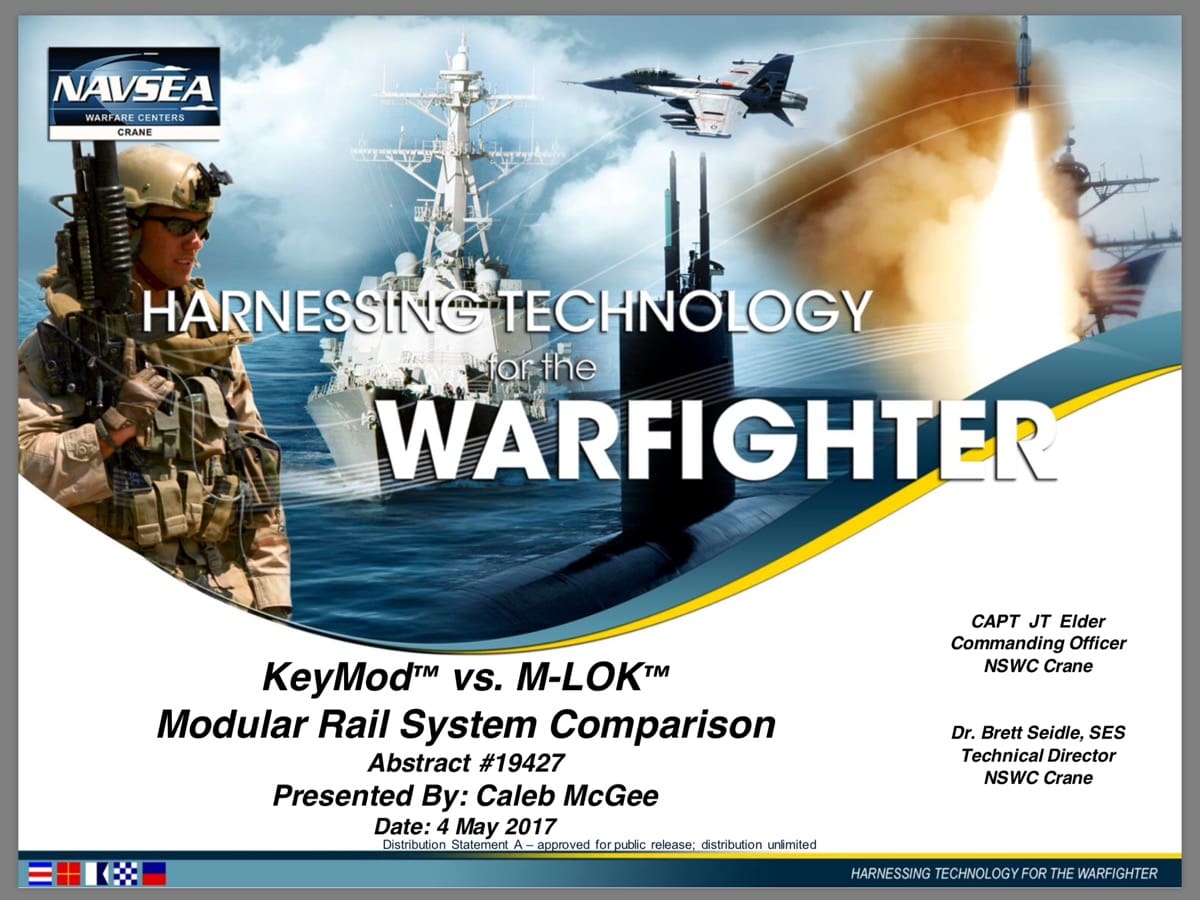
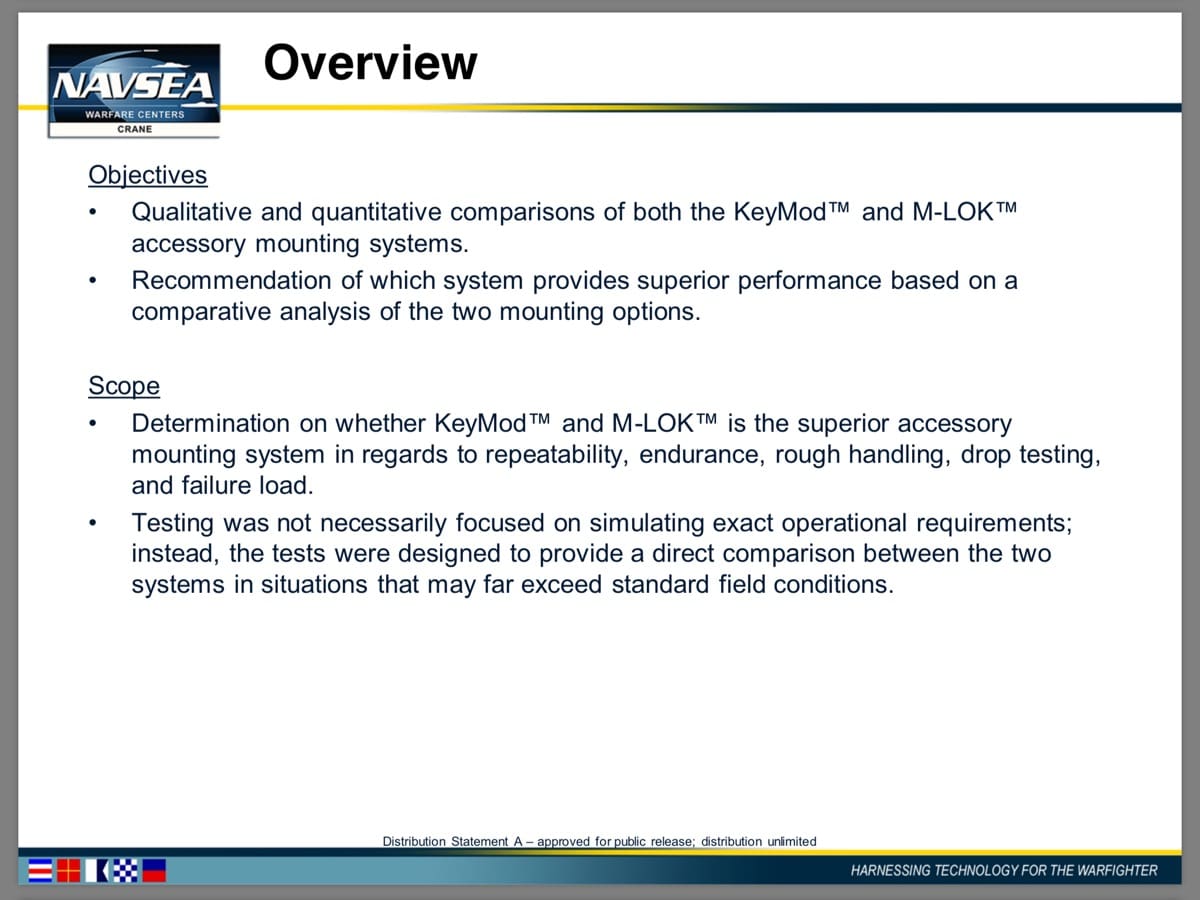
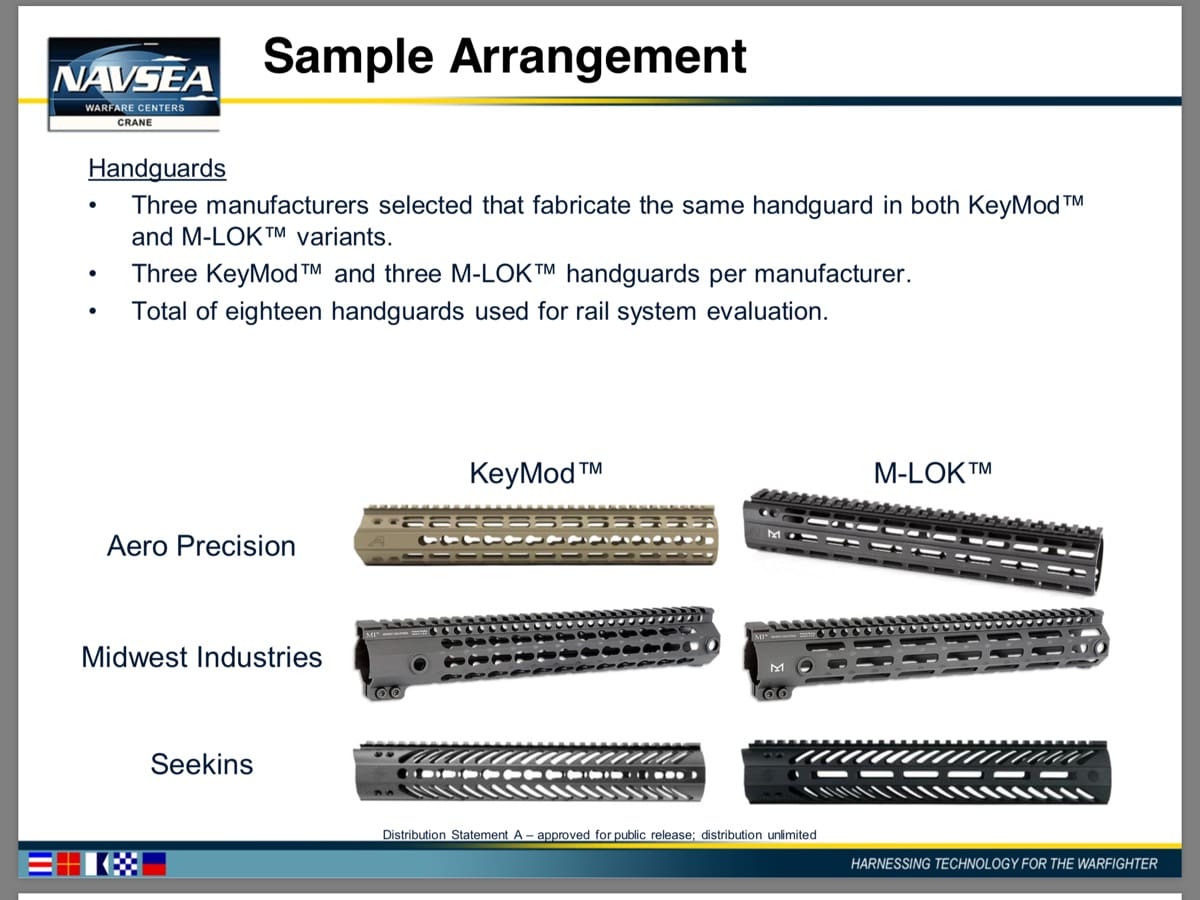
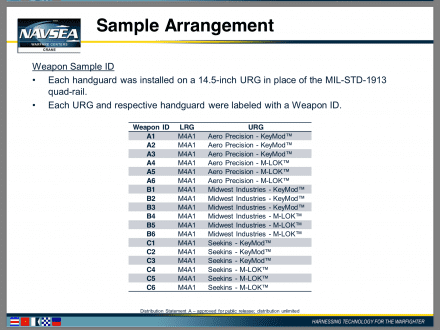
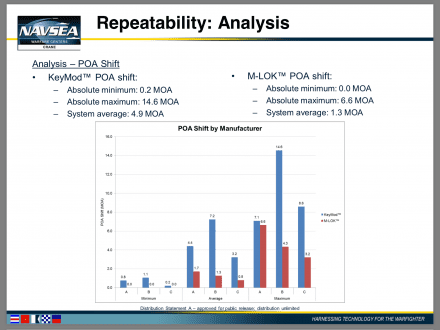
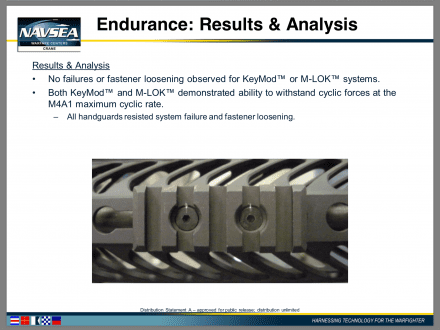
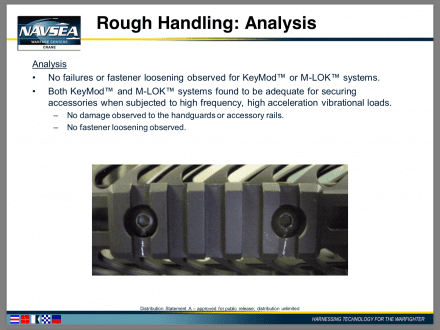
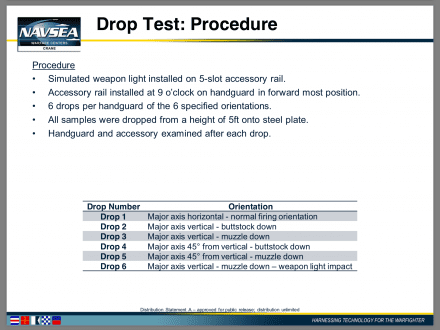
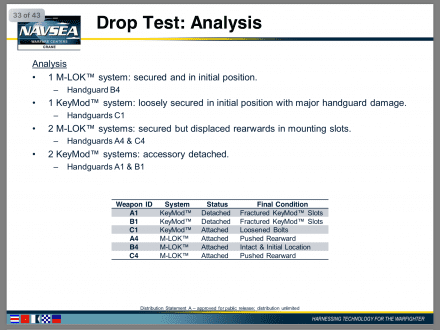
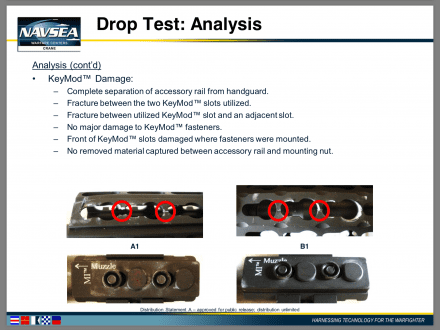
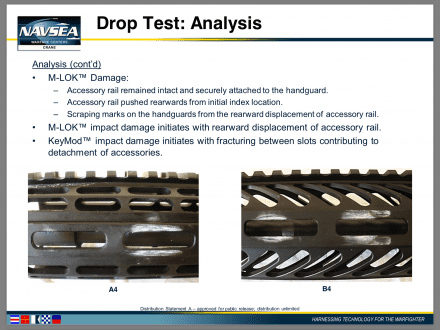
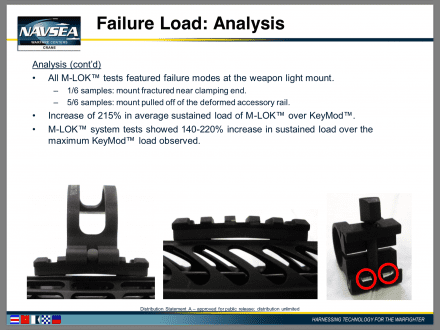
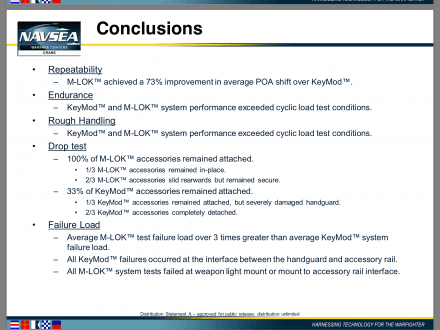
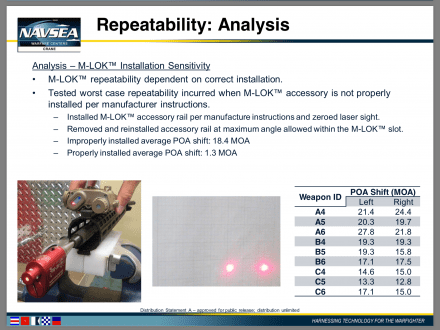
Finally we have something official to reinforce what everyone already knew. Thanks for the info, time to watch people get butt hurt!
Very interesting. I wonder how many years this will get out to every single platform in SOCOM (NSW, USASOC, AFSOC and MARSOC)???
This may happen sooner than you think. Look for an article to explain why next week on SSD.
Word, thanks!
Good Stuff! Glad we get to see this.
And the reason everyone moved away from MIL-STD-1913 rail systems is because of the weight issue? Or…some other reason?
Weight and cost.
Thanks.
Weight…and overall outside diameter of the 416 quadrail. The OD produced offset of accessories plus bulk in the users hand and when slung.
Testing based on a sample set that included Aero Precision and Midwest as two of the three… Really…?!?
Not Gucci enough for you?
There was some initial data from the white paper that informed this test protocol, and, IIRC, the test samples used for that were Geissele, BCM, Noveske, and Hodge. Crane may have simply been deconflicting to add a larger spread of MFG, as the white paper said the same thing.
An important element of this test was that they use rails which featured both M-LOK and KeyMod yet were made by the same manufacturer in order to mitigate the differences in quality between different manufacturers.
“Not Quality enough for you?” Fixed that for you… Seriously, I’ve used both, to say their product could have used a little more time on the CNC would be an understatement. To use either in this test while omitting a mfr. like Geissele does nothing to enhance the underlying credibility.
Quality among various handguards wasn’t being tested, that wasn’t the point. Keymod vs M-LOK was. Geissele does not do Keymod and BCM does not do M-LOK (yet).
FWIW, Geissele did KeyMod for a fair bit of time, on their MK4 and MK5 line, before switching over to M-LOK.
The fact that they stopped making one in favor of the other might be a clue…
Geissele’s ALG does both mlok and keymod.
I have a BCM K-Mod rail and have been eyeballing M-Lok for some time but never has any real reason to switch (too much $$$). I love the BCM rail lock up to URG (very sturdy), now with M-Lok it will be an all around better package.
As mentioned, Geissele and others that probably meet your standards were in the original exploratory data/white paper. The numbers are essentially identical when comparing apples to apples.
That is, the numbers for M-LOK versus KeyMod ended up largely the same in this full test as from the preliminary white paper.
Even if the were total UTG level airsoft it would still be about the design. Just a convenient cheap way to test a lot of handguards with both designs. MLOK is simpler and that design philosophy is rarely a bad thing….
So for the average civiejoe Keymod is just fine as it seems to hold up well but for the guys kickin doors the Mlok may be a more stable mounting platform, if I read this correctly?
Fine as long as you never drop your rifle
But SIR!!! that never happens in the real world.. I mean COD…
Unless you drop your rifle six times from 5″. On a steel plate.
I’m not getting rid of any of my keymod stuff.
I won’t be getting rid of any of my Keymod stuff, either. That said, I never got rid of my RIS II rails either! They may be wider. They may be heavier. They may be cheese-gratier. But they’re built to last.
Very interesting. Thanks for posting.
Looks like they might have made a mistake on one of the photos, though: On the Drop Test Analysis slide showing M-LOK damage, sample B4 is clearly a Seekins handguard, where the Sample Arrangement slide shows that B4 should be a Midwest Industries handguard.
Considering that the Picatinny rail became a NATO standard, will any of these become soon?
Y’all can put cheesegraters on your bullet chuckers if you want. but me and all other good hearted people of the world use M-Lok
Really? Here’s a cookie, now go away.
and we have our first butt hurt keymod fanboi
I prefer Keymod, now before you MLOK whores start the hate, let me just say this about the Competition that USSOCOM conducted. For one the military/law enforcement use what’s cheapest and quantity over quality when it’s towards their standard issued weapon. I know this because while I was infantry we used what was given whether beaten/used and same when I was SOF. Obviously much more flexible with certain gear and better than the standard issued, but still whatever was issued or there we ran it. No fancy Keymod or MLok like you see most of the big names out there using. I think this competition would’ve been fairer if they used better quality companies and rails. For example BCM vs Geissele or Daniel Defense MFRxs vs SLiM Rails. Just because the choices they used aren’t the best options or “quality.” Also because the department I’m at just cleared us for use with Keymods. Haha
While I agree, most issue gear is best value, your suggestion regarding testing doesn’t make any sense. They evaluated the two systems by using rails made by the same manufacturer for both types. That took a lot of variance in quality between manufacturers out of the equation.
Damn you with your logic and facts SSD!!!
but seriously, yes. Too many gear whores here bitching about “low quality” manufactures and missing the point that you make, that they were looking to remove possible product quality from the equation by selecting handguards models that were made by the same manufacturer that came in both M-LOK and K-MOD.
And honestly, none of those 3 manufacturers have a bad name. They may be in the top 1%, but they all have good reputations.
Err, I suck at typing. I meant to type at the bottom that while the 3 that were selected may NOT be in the top 1%.
Thanks again SSD for putting great info out there..keep up the good work amigo.
First off, how cool is it that they made a machine that simulates firing a rifle like that, and, programmed it to simulate a mag dump, reload and mag dump. That’s actually fascinating in an odd kind of way.
I got a KAC RIS darn near 20 years ago and never had an issue with it. Later on before we went with the RAS I got to do a little test and review of some of the other systems, and one of them, the early SIR handguards from ARMS as I recall, wasn’t thought of too highly simply for its detachable rails among other things. Now, everything is detachable. So having been in the mix with a triangle handguard M16A1 in the beginning through to the laser and light show on the M4s this is really interesting to see the evolution in thinking and employment.
For me and my purposes though a standard railed arrangement works just fine. Most are bulky as sin but I’ve settled on LaRue, they’re the lowest profile I’ve found. Just the basic lo-pro, ladder rail covers keeps you far enough off toasty aluminum in rapid fire. But hey, I’m just a hobbyist now so it don’t matter as long as I’m content with my purchase.
Just wondering if there’s data showing difference between 1913 rail and MLok rails with the testing fields used here. I know SSD mentioned the girth but size wasn’t a comparative field in this test. If I wanted a end all be all durable rail system would it be Mlok or 1913?
Crane did not conduct any testing on Picatinny as a baseline. Their task from USSOCOM was KeyMod and M-LOK.
mlok, being recessed attachment on the hg, and rails being replaceable is far superior for a military cost perspective. Not uncommon for 1913 rails to become so damaged that they no longer provide fixed position clamping. And only option at that point is complete replacement.
I would like to see a comparison between these systems and normal rails, and see if the conclusion is if to save a fraction of weight and width the failures are worth it on a fighting firearm
The weight thing perplexes me. These are aluminum rails and thin ones at that. Weight savings is seriously going to be in ounces and tenths of ounces. Cue the ounces equals pounds equals pain mantra; I get it, I’ve carried this junk too. When worried about POI shift you’re stacking tolerances now with additional rail sections and adapters that’ll only stack even higher over the life of the weapon.
Counterpoint to my own point, if a fully railed handguard is damaged the entire unit has to be replaced. On an m-lok only the damaged adapter would need to be provided it didn’t bust the rail too. There’s give and take with both.
I suspect that the handguard width concern has much to do w/ female “equality”/accessibility concerns — a large reason for switch away from M9s as well… Wide grips fit men’s hands well (usually including full c clamp grip if desired) whereas women’s hands often grasp 2/3rds that.
Smaller handguards mean one less reason for women to underperform men.
So…remind me again what precisely the HK proprietary rail system uses? I have one on my HK MR762, but got the Geissele rail for my HK MR556.
HKEY 😉 its not key-slot
A Dimes worth of diff. to we civilians.
I feel there needs to be more info on what you did in the tests and how you did them. Not only for cross-examination of methods and validity of tests, but also for reproducibility. I understand this is an explanation of the SOCOM decision, and I see a summary version. Is there a publically available detailed report on the testing available? If so, where?
I’m a moron, I missed the last link for detailed brief.